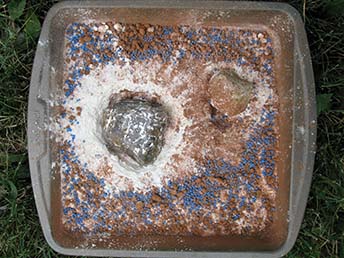Last updated: August 14, 2020
Lesson Plan
Asteroid Impact Model

- Grade Level:
- Upper Elementary: Third Grade through Fifth Grade
- Subject:
- Science
- Lesson Duration:
- 30 Minutes
Essential Question
What does it look like when an asteroid crashes into the moon and how are craters formed?
Objective
Students will create a fun and interactive model to look at the impact craters left behind by an asteroid and explore the surface of the moon!
Background
The face of the moon is covered with impact craters left behind by asteroids that have struck the moon throughout its existence. Lunar dust is fine mineral powder that moves easily when an asteroid crashes into the moon. Let’s find out how!
You Will Need:
- A pan of any size, the bigger the better (foil pans are recommended)
- Flour
- Sprinkles and cocoa powder (optional)
- Hard objects like rocks, washers, bolts, etc. of various sizes
What to Do:
- Fill the foil pan with a thick layer of flour to represent the dust on the surface of the moon
- Cover the flour with a layer of sprinkles and a third layer of cocoa powder (optional step)
- Drop heavy items onto the surface of the ‘moon’ and look at the impact craters the heavy objects leave behind. Try throwing the objects from different heights and angles.
Preparation
This activity is a good visualization of the surface of the moon. Teachers can prepare their class for this activity by providing background on asteroid impacts and the surface of the moon including the movement of the moon around the Earth and the ‘dark side of the moon’.
Materials
Download Printable - Asteroid Impact Model
Procedure
- Prepare materials for your class: foil pans, flour, sprinkles, and cocoa powder. This activity works best in groups of four to five students and can be messy. An outdoor setting is recommended if possible.
- Fill the bottom of each pan about 1-2 inches with flour, then coat with sprinkles and cocoa powder
- Allow students to take turns dropping or throwing their heavy objects (small rocks, metal nuts or bolts, etc.) into the flour. Let them explore different heights and angles and different sized objects.
- Conclude the model experiment by allowing the students to discuss their observations.
- For further thinking, teachers may ask students what are some factors that could be different from this model and the moon: gravityand atomosphere!
Additional Resources
https://www.jpl.nasa.gov/edu/teach/activity/make-a-crater/
